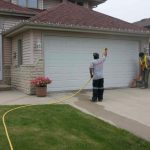Signs You Need Mudjacking
Signs You Need Mudjacking. Is Your Concrete Crying Out for Help? Sunken, uneven concrete isn’t just an eyesore; it’s a safety hazard and can lead to more significant structural problems down the road. If you suspect your concrete might be settling, you’re probably wondering if mudjacking is the right solution. This comprehensive guide will walk you through the key signs that indicate your concrete needs a lift, helping you make an informed decision about repair. Understanding the Underlying Issues: Before diving into the signs, it’s helpful to understand why concrete settles in the first place. Common culprits include: Soil Erosion: Water runoff, improper drainage, and even tree roots can erode the soil beneath your concrete, creating voids. Soil Compaction: Over time, the soil under your concrete can compact, leading to settling. Expansive Clay: Certain clay soils expand and contract with moisture changes, causing the concrete to rise and fall, eventually leading to unevenness and cracking. Poor Initial Construction: In some cases, inadequate base preparation during the initial concrete pour can contribute to settling. Deciphering the Signs: When to Call a Mudjacking Professional: Now, let’s explore the telltale signs that suggest your concrete needs mudjacking: Visible Settling: This is the most obvious indicator. You’ll notice a section of concrete that’s clearly lower than the surrounding slabs. This creates tripping hazards, affects drainage, and can even compromise the structural integrity of adjacent structures. Pay close attention to driveways, walkways, patios, and pool decks. Cracks (and the types of cracks): While some minor hairline cracks are normal due to concrete shrinkage, significant cracking, especially when accompanied by unevenness, is a red flag. Look for: Diagonal Cracks: These often indicate differential settling, where one part of the slab has settled more than another. Long, Continuous Cracks: These can signify ongoing settling or structural issues. Multiple Interconnected Cracks: A network of cracks suggests a larger problem with the underlying soil. Pooling Water: If water consistently pools on your concrete surface, it’s a clear sign of improper drainage due to settling. Standing water can lead to further damage, including freeze-thaw cracking in colder climates. Gaps and Separations: Gaps between concrete slabs, or between the concrete and adjacent structures (like your house foundation, garage, or patio), often indicate settling. These gaps can also become entry points for pests and weeds. Tilting or Leaning: If your concrete slab appears to be tilting or leaning, it’s a strong indication of soil shifting and the need for mudjacking. This is particularly concerning for steps, retaining walls, and other vertical concrete structures. Doors and Windows Sticking: In some cases, settling concrete can affect the framing of nearby doors and windows, causing them to stick or become difficult to operate. This is a less direct sign, but it’s worth investigating if you notice other signs of settling. Uneven Steps: If the steps leading to your porch, patio, or walkway are uneven, it creates a significant tripping hazard. Mudjacking can effectively raise and level sunken steps. Don’t Delay: The Importance of Timely Repair: Addressing concrete settling promptly is crucial. Ignoring the signs can lead to: Worsening Damage: Continued settling can exacerbate existing cracks and create new ones, eventually requiring more extensive and costly repairs. Safety Hazards: Uneven surfaces pose a tripping risk, potentially leading to injuries. Decreased Property Value: Damaged and uneven concrete detracts from your home’s curb appeal and can lower its value. What to Do if You Suspect a Problem: If you notice any of these signs, it’s a good idea to consult a reputable mudjacking professional. They can assess the situation, determine the underlying cause of the settling, and recommend the best course of action. A qualified contractor will: Evaluate the extent of the damage. Inspect the surrounding area for drainage issues. Determine the appropriate mudjacking technique. Provide a detailed estimate for the repair. Mudjacking: A Cost-Effective Solution: Mudjacking offers a less expensive, less disruptive, and often equally effective alternative to complete concrete replacement. It’s a proven method for raising sunken concrete slabs, restoring their original level, and preventing further settling. Do you have signs of sunken concrete? Let MuddRuckers solve it for you. With fast, effective lifting solutions. Get a QuoteExplore Costs

